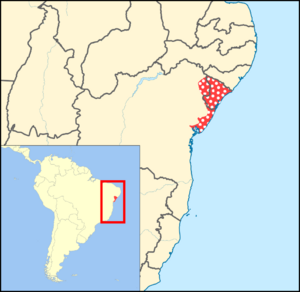Coimbra Filho's titi monkey facts for kids
Quick facts for kids Coimbra Filho's titi |
|
|---|---|
 |
|
| Conservation status | |
| Scientific classification | |
| Genus: |
Callicebus
|
| Species: |
coimbrai
|
 |
|
| Geographic range | |
The Coimbra Filho's titi monkey (Callicebus coimbrai) is a small monkey. It is also known as Coimbra's titi. This type of New World monkey lives only in Brazil. These monkeys are found in the forests of the Brazilian states of Bahia and Sergipe. A scientist named Shuji Kobayashi first discovered them. The monkey is named after Adelmar F. Coimbra-Filho. He was a famous Brazilian scientist who studied monkeys. This titi monkey is one of the most endangered primates in its region.
Contents
What Does the Coimbra Filho's Titi Look Like?
The Coimbra Filho's titi monkey has some special features. Its forehead, the top of its head (called the crown), and its ears are black. It also has a pattern on its back that looks a bit like a zebra.
Scientists can also tell this titi apart by its skull and teeth. Its skull is smaller than other similar titi monkeys. Its teeth are shaped more like a "U" than a "V". This helps scientists identify them.
Where Do Coimbra Filho's Titi Monkeys Live?
Coimbra Filho's titi monkeys like to live in thick forests. They prefer areas with dense plants close to the ground. They also like the lower parts of the tree canopy.
These monkeys can survive even if their forest home is damaged. They can live in forests that have been cut down or broken into smaller pieces. This is because they can adapt to disturbed areas. They can also live in forests that are young or growing back.
While other titi monkeys live across South America, Coimbra Filho's titi lives in a very small area. They are only found in the coastal parts of northeastern Brazil. This includes parts of the states of Bahia and Sergipe.
How Do Coimbra Filho's Titi Monkeys Behave?
Coimbra Filho's titi monkeys mostly eat leaves and fruits. They are known as folivore-frugivores. This means their diet is a mix of leaves and fruits.
These monkeys usually live in small family groups. A group typically has three to five members. This includes a mother and father pair and their young. When the young monkeys grow up, they leave their family group. They then find new areas to live in.
The size of their home range can vary. Some groups might use an area as small as 2 ha (4.9 acres). Others might use a larger area, over 20 ha (49 acres). Coimbra Filho's titi monkeys are very protective of their home. They can be quite aggressive if they feel threatened.
Why Are Coimbra Filho's Titi Monkeys Endangered?
The Coimbra Filho's titi monkey is an endangered species. It is listed as endangered on the IUCN Redlist. Many things threaten them, both natural and caused by humans. These threats include losing their homes and their habitats being broken up. They also have limited chances to reproduce.
One big problem is how their habitat is broken into pieces. When young monkeys leave their family groups, it's hard for them to find new mates. This limits how many babies can be born. It also reduces the variety in their genes.
Their small natural home also makes them vulnerable. They only live in the Atlantic coastal forests of northeastern Brazil. This is a small area. Any changes to this area can greatly affect the monkeys.
Humans are a major cause of their problems. People are developing areas around their habitat. Roads are being built, and tourism is growing. Logging is also a big issue, as forests are cut down. Many wooded areas are being turned into pastures for farm animals.
By the early 1900s, the coastal forests in Sergipe were already much smaller. Now, these forests cover less than 1% of their original size. This loss of habitat breaks up the monkey's home. This makes it harder for them to find food and mates. It also makes them more likely to be hunted by predators.
In 2003, the Coimbra Filho's titi was put on Brazil's Official List of Threatened Fauna. An organization works to study these monkeys. They also create plans to help protect them.
As of 2005, there were only about 500 to 1000 Coimbra Filho's titi monkeys left in the wild. No special programs had been started to breed them in zoos.
Recent studies show some hope for the species. They have many small groups, and they can handle some habitat loss. But action is still needed to protect their homes. Plans must be put in place to help them survive for the future.


